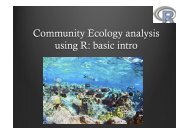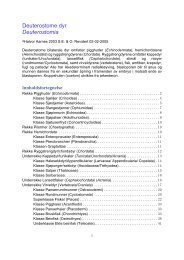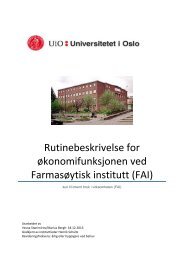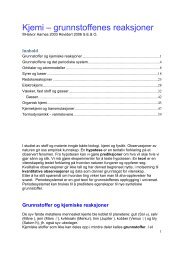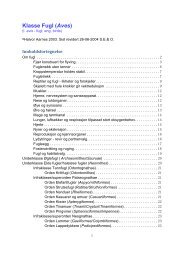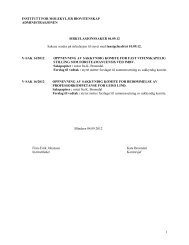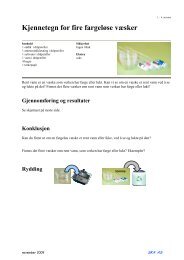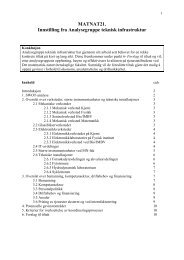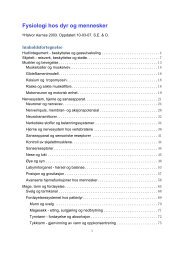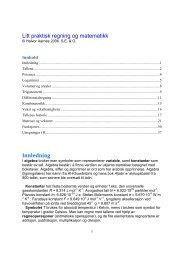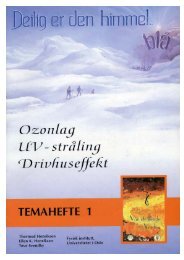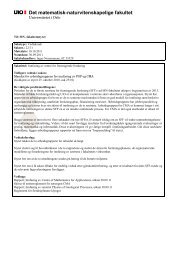Evaluation of individual research units - Norges forskningsråd
Evaluation of individual research units - Norges forskningsråd
Evaluation of individual research units - Norges forskningsråd
You also want an ePaper? Increase the reach of your titles
YUMPU automatically turns print PDFs into web optimized ePapers that Google loves.
University <strong>of</strong> Oslo<br />
Department <strong>of</strong> Biology<br />
<strong>Evaluation</strong> <strong>of</strong> biology, medicine and health <strong>research</strong> in Norway (2011)<br />
Description <strong>of</strong> institution<br />
The Department <strong>of</strong> Biology was formed from a number <strong>of</strong> <strong>research</strong> groups that existed<br />
before 2007, at which time the department was reorganised into three <strong>research</strong> programs<br />
and one interdisciplinary centre <strong>of</strong> excellence, the Centre for Ecological and Evolutionary<br />
Synthesis (CEES). Oslo University as a whole was also reorganised in 2005 into its<br />
current structure; each department has a head who serves for four years and, with the<br />
assistance <strong>of</strong> the head <strong>of</strong> administration, works with the department and university board<br />
to plan for the future. The <strong>research</strong> programs each have a chair and a vice chair who<br />
report to the head <strong>of</strong> department. The <strong>research</strong> programs are deliberately limited in scope<br />
and teaching undergraduates is not their primary mission.<br />
The composition <strong>of</strong> personnel in the department has changed rapidly over the last several<br />
years. The number <strong>of</strong> PhD students increased from nine at the beginning <strong>of</strong> 2005 to 23 at<br />
the end <strong>of</strong> 2009. The total number <strong>of</strong> PhD students enrolled at the department in 2009,<br />
including both internally- and externally-funded fellowships, was 60. At that time there<br />
were 32 permanent scientific staff members. Women are well represented among PhD<br />
students and post-doctoral <strong>research</strong>ers but the department becomes more male-biased at<br />
senior levels.<br />
General evaluation & recommendations<br />
The department is making excellent progress towards its goals, and the Panel were<br />
impressed by the degree <strong>of</strong> substantive change in the department over the last several<br />
years. The rate and quality <strong>of</strong> publications increased following the reorganisation, and we<br />
noted that the productivity <strong>of</strong> many <strong>of</strong> the members <strong>of</strong> the department is extremely high.<br />
A concern we had, which seems to be shared to some extent by the members <strong>of</strong> the<br />
department as expressed in the self-assessment and the panel meeting, was to prevent<br />
domination <strong>of</strong> the department by the CEES, which currently has the largest number <strong>of</strong><br />
<strong>research</strong>ers by far in the department. The CEES secures much <strong>of</strong> the <strong>research</strong> funding,<br />
and has high visibility. The work <strong>of</strong> this centre is excellent, as detailed below, but for the<br />
overall health and viability <strong>of</strong> the department, it is essential to make strategic decisions<br />
about growth in the other <strong>research</strong> groups as well. In particular, the Marine Sciences<br />
group is rather small. We recommend developing an explicit succession plan for the<br />
group in terms <strong>of</strong> its leadership and continued funding.<br />
We recommend appointing one or two people to help members <strong>of</strong> the department assess<br />
international opportunities for basic <strong>research</strong>, particularly EU funding, so that <strong>individual</strong><br />
<strong>research</strong>ers can take advantage <strong>of</strong> as many calls for proposals as possible. The creation <strong>of</strong><br />
small grants or discretionary funds for exploratory <strong>research</strong> is also a potential solution.<br />
Follow up <strong>of</strong> previous evaluation<br />
The department responded to the previous evaluation by undertaking the reorganisation<br />
described above, with an emphasis on <strong>research</strong> groups excelling in particular areas rather<br />
45




